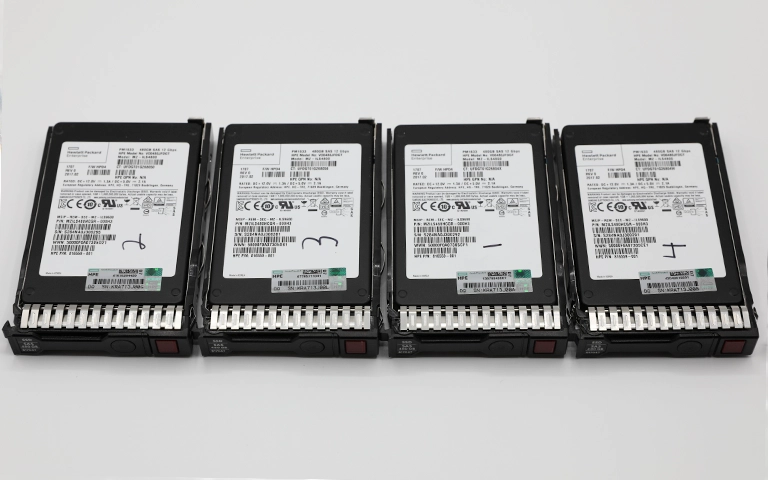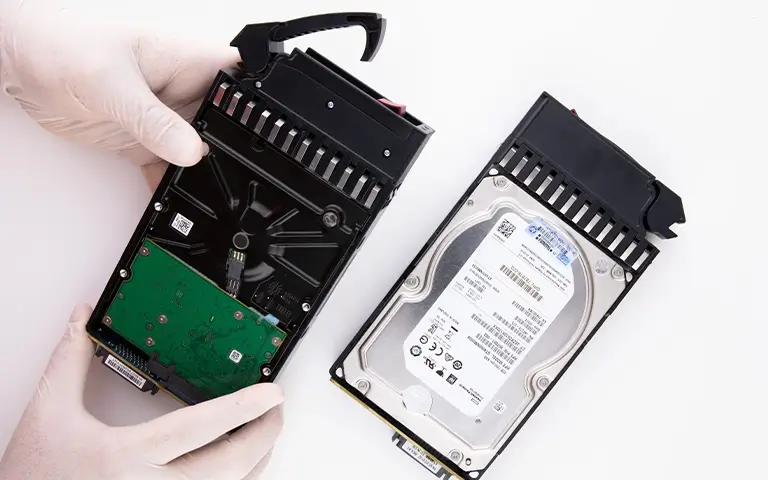RAID 10 is one of the most trusted configurations for organisations that need both speed and robust data protection. It combines the advantages of RAID 0 and RAID 1, delivering a balance between high performance and redundancy.
In this layout, data is both mirrored and striped across multiple drives, which makes it highly reliable for servers, databases and enterprise environments where uptime is essential.
Even if one or more drives fail within the allowable limits of the configuration, the array can continue to operate without losing critical data.
In this guide, we will explain how RAID 10 works, compare it with other RAID levels and outline how professional recovery services can assist when unexpected failures occur.

Fast turnaround times for business-critical data
How RAID 10 Works
RAID 10, often described as RAID 1+0, combines two techniques: striping and mirroring. It uses a minimum of four drives, grouped into mirrored pairs, with data then striped across those pairs.
Mirroring (RAID 1) keeps an identical copy of the data on two drives, providing redundancy. If one drive fails, its mirror can continue to serve data so the system remains online without immediate data loss. Striping (RAID 0) then spreads data across the mirrored pairs, improving read and write performance.
This structure delivers both speed and protection, which makes it well suited to servers that require fast response times and continuous availability. The trade off is capacity; only half of the total raw storage is usable because the remainder is reserved for mirrors.
To explore the concept of striping in more detail, see our post What Is RAID 0, which explains how data striping can enhance system performance.

RAID 10 vs Other RAID Levels
To see where RAID 10 fits compared with other common configurations, here is a straightforward comparison with RAID 5 and RAID 0.
For a wider look at parity based redundancy, you can also read RAID 5 vs RAID 6 to see how these levels compare in terms of data protection and recovery.
Advantages of RAID 10
RAID 10 is a frequent choice for organisations that prioritise both speed and reliability. By combining mirroring and striping, it delivers several advantages that make it well suited to demanding storage environments.
Excellent performance: Data is striped across mirrored drives, delivering fast read and write speeds for intensive workloads such as databases and virtual machines.
Strong fault tolerance: Each mirrored pair can withstand a single drive failure without compromising overall system performance or data integrity.
Fast rebuild process: When a failed drive is replaced, only the data from its mirror needs to be restored, which shortens rebuild times compared with parity based arrays.
High data reliability: Mirroring ensures every file is stored on two drives, significantly reducing the risk of permanent data loss.
Ideal for mission critical systems: RAID 10 supports continuous uptime, making it suitable for business servers, core applications and real time databases.
If you would like to explore more RAID options and how they compare, see Types of RAID for a detailed overview.

Limitations of RAID 10
Although RAID 10 delivers excellent performance and reliability, there are several trade offs you should evaluate before deploying it in production.
High cost of implementation: RAID 10 uses twice as many drives because half of the total capacity is reserved for mirrors, which increases hardware expenditure.
Lower storage efficiency: Only around 50% of the total disk space is available for live data, with the remainder dedicated to mirrored copies.
Limited scalability: Expanding a RAID 10 array can be complex and may involve reconfiguration or planned downtime, depending on the platform and controller.
No protection against logical failures: While it guards against physical disk failures, RAID 10 does not protect against file system corruption, malware or accidental deletion.
Dependent on RAID controller quality: Overall performance and stability rely heavily on the RAID controller’s ability to manage striping and mirroring reliably at the same time.
For insight into how drive reliability impacts RAID arrays, see our guide on RAID Failure Rate.
Data Recovery from RAID 10 Arrays
Recovering data from a RAID 10 system requires specialist expertise because of its combined mirroring and striping architecture. Each drive contributes to both performance and redundancy, so any damage, misconfiguration or failed rebuild attempt can significantly complicate recovery.
When multiple drives fail or the RAID controller becomes unstable, trying to rebuild the array without professional tools can result in data being overwritten or further corrupted. It is essential to approach recovery in a controlled way and avoid ad hoc manual repairs.
At RAID Recovery Services, our engineers specialise in restoring data from damaged RAID 10 arrays. We identify the original layout, rebuild the mirrored pairs and then reconstruct the striped structure in order to extract intact files. Every stage of the recovery is carried out in a secure, controlled environment to preserve data integrity.
If your RAID 10 array becomes inaccessible or begins to show repeated errors, stop using the system immediately. Continued operation can accelerate drive degradation or overwrite data that is still recoverable.
For detailed guidance on safe recovery practices, see Troubleshoot RAID Failure or RAID Controller Failure Recovery.

Is RAID 10 Right for Your Business?
RAID 10 is an excellent option for organisations that demand both speed and resilience. It delivers high performance for critical workloads such as databases, web servers and virtualised systems, while mirroring provides robust protection for your data.
However, this configuration is best suited to businesses that can invest in additional drives and ongoing maintenance. For smaller operations with limited storage requirements or tighter budgets, other RAID levels such as RAID 5 or RAID 6 may provide a better balance between cost and redundancy.
When it is implemented and monitored correctly, RAID 10 offers long term stability, minimal downtime and rapid recovery following drive failures. Even so, the most reliable arrays can still experience unexpected issues.
If your RAID 10 system fails or becomes corrupted, our specialists can help restore it safely. RAID Recovery Services provides end to end diagnostic, repair and data recovery support for enterprise and server environments.
To learn more about common causes of RAID failures, see Reasons for RAID Data Loss.
If your system shows signs of drive failure, corruption or array degradation, contact RAID Recovery Services for an expert assessment and secure data restoration.
Trust the experts with proven results
Frequently Asked Questions
What is RAID 10 used for?
RAID 10 is primarily used in enterprise servers, databases and high performance systems where both speed and data protection are essential. It combines mirroring and striping to deliver fast access times with strong redundancy.
How many drives are required for RAID 10?
A minimum of four drives is required for a RAID 10 configuration. Two drives are used for mirroring, while the other pair provides striping to improve performance. Larger arrays simply scale this pattern.
What happens if one drive fails in RAID 10?
If a single drive fails, its mirrored partner keeps the array running without data loss. The failed drive can be replaced and the system will rebuild the mirror in the background while remaining online.
Can RAID 10 fail completely?
Yes. If multiple drives from the same mirrored pair fail before a rebuild completes, the array can suffer data loss. Controller faults, firmware issues or file system corruption can also cause a full system failure.
How is RAID 10 data recovered after a failure?
Professional recovery typically involves confirming the correct drive order, rebuilding the mirrors and then reconstructing the striped data. RAID Recovery Services uses specialist tools to extract and restore data safely from failed RAID 10 arrays.